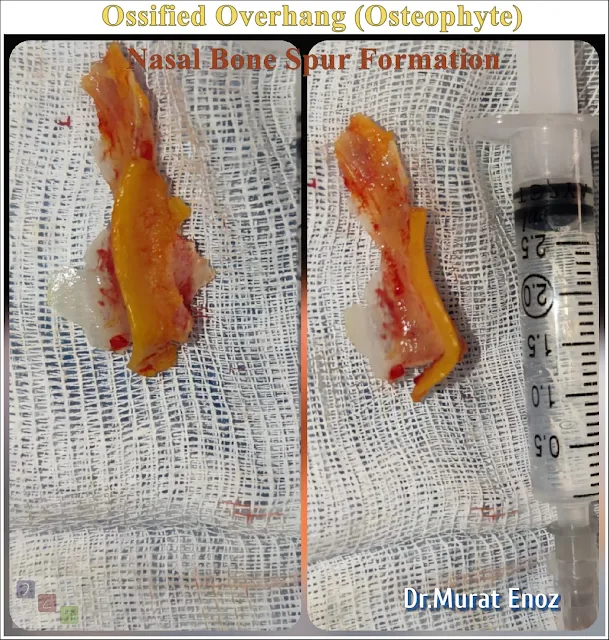Complicated Secondary Revision Rhinoplasty + Nasal Synechia Surgery + Nasal Septal Spur Removal Surgery
In the examination of the patient, who had previously undergone rhinoplasty in a different clinic and had complaints of nasal deformity and nasal congestion, the following were found:
- adhesion (approximately cm long) in the anterior part of the left nasal cavity, between the nasal septum and the inferior turbinate mucosa
- septal spur formation on the left posterior side of the nasal septum, again posterior to the left nasal cavity (in contact with the posterior turbinate inferior)
- columella (hanging columella) which is more prominent on the left when viewed from the side
- asymmetry between the nostrils
- droopy nose tip
- weak left upper lateral cartilage
- asymmetry in the nasal bone
The patient with these findings underwent revision rhinoplasty using rib cartilage, septoplasty, septal spur removal, and inranasal nasal synechia removal surgery.
During the operation, after the skin was dissected and lifted, it was observed that the alar cartilages at the tip of the nose were quite different from each other, and the dome points, inner and outer crus were in different sizes. When possible, amymetries were tried to be removed with the overlapping technique and various cartilage graft applications. Sometimes in noses with highly modified anatomy, it may not be possible to achieve a fully symmetrical result with a single operation. In the video above and in the photos below, you can find the images of the nose before and after the operation.
A patient with thick skin features seems to take a little longer than usual for the recovery time and the time required for the edema to disappear completely.
Typical symptoms in patients with intranasal synechia are the gradual decrease in the amount of air they breathe, within a few weeks, after the tampons are removed from the nose. What occurs here is that the tissue that narrows the nasal air passage causes nasal congestion again. Especially in the case of using old-style nasal packings, which can cause mutual mucosal damage, or removing the nasal packings earlier than normal, the likelihood of synechia increases. In patients with excessive septum deviation in the nose and contact points with the lateral nasal wall or turbinates in the deviation areas, not excising the bur deviasypn areas and maintaining mucosal contact may also facilitate the formation of synechia.
2 Weeks After Surgery
Above you can find the photos taken after 2 weeks. A rather natural and rather symmetrical nose than before. It is still quite edematous. Most of the patient's breathing problems disappeared. In this way, after complicated nose operations, recovery may be slower.
Keeping the internal silicone splints in the nose for a week can reduce the possibility of adhesion!
During nasal surgeries, as a result of mutual injury of the mucous membranes in the nasal cavity, if there is no barrier between the damaged mucosal areas, that is, if the nasal pads are not kept in the nose for a sufficient time, mutual healing tissues, namely adhesions, may occur between the mucous membranes. We generally prefer to use techniques that reduce mucosal injury in the nose, and we recommend keeping internal nasal silicone splits for about a week.
Murat Enoz, MD, Otorhinolaryngology, Head and Neck Surgeon
Private Office:
Address: İncirli Cad. No:41, Kat:4 (Dilek Patisserie Building), Postal code: 34147, Bakırköy - İstanbul
Appointment Phone: +90 212 561 00 52
Appointment Phone: +90 212 561 00 52
Fax: +90 212 542 74 47













Comments
Post a Comment